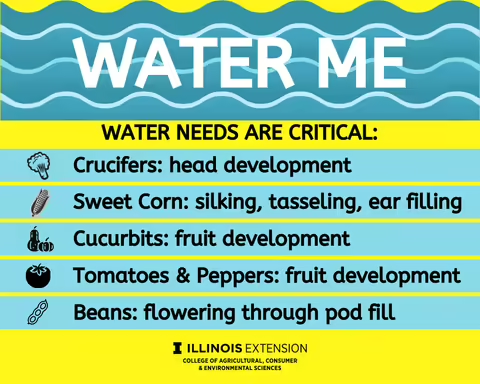URBANA, Ill. – The extreme heat has created some vegetable garden challenges. Garden plants (and all other kinds of plants) respond to the weather conditions by adjusting vegetative foliage and reproductive fruit growth.
"When it is too hot for us, we go inside to the air conditioning or move into a shady spot in the yard," says Richard Hentschel, University of Illinois Extension horticulture educator. "Our vegetables must remain in the sun, so if it is too hot and dry, tomatoes and peppers will abort any unopened flowers until better weather conditions return. This protects the plant from attempting to fulfill a fruit when water is lacking and maintaining itself under better conditions."
Right now, as vegetables are moving from the general growth stage to producing flowers,fruits, and seed pods, a consistent level of soil moisture is critical for health and for harvesting high quality, nutritious fruits and pods. For example, cucumbers will go from a pollinated flower to a harvestable fruit in about a seven day period, Hentschel says. "If soil moisture is lacking at any point, you find yourself with cucumbers that appear normal on one end and taper down on the other and can be bitter tasting. If you’re going for a larger, longer cucumber, the fruit may appear fat, then skinny, then fat as the available water has changed."
In extreme heat, snap beans may not fill the bean pod. Lettuce slows its growth and leaves may not have the same expected tenderness. Onion bulbs will stop growing without adequate water and won't resume growth even if water is reintroduced.
Hentschel outlines the water-critical development stage for popular vegetables:
-
Crucifers: head development
-
Sweet corn: silking, tasseling and ear fill
-
Cucurbits: fruit development
-
Tomatoes and peppers: fruit development
-
Beans: flowering through pod fill
SOURCE: Richard Hentschel, Horticulture Educator, Illinois Extension
ABOUT EXTENSION: Illinois Extension leads public outreach for the University of Illinois by translating research into action plans that allow Illinois families, businesses, and communities to solve problems, make informed decisions, and adapt to changes and opportunities.
